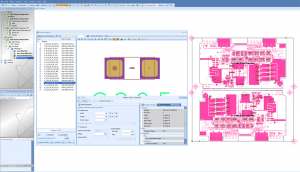Eight Steps for PCB Assembly Success

By Mark Laing, Valor Division of Mentor, A Siemens Business

Mark Laing
With today’s demand for innovative and advanced electronic products, performance and productivity are under threat with rapidly increasing pressure on engineering and materials infrastructures. There are eight key steps engineering teams need to consider to ensure PCB assembly success for electronics manufacturability.
#1: Know your products.
Knowing the accurate details and requirements of the product to be manufactured is essential. Manufacturing processes need to match product requirements efficiently for performance quality. The manufacturing product model is one of the most significant uncontrolled variables that directly affects manufacturing. If issues are encountered after manufacturing engineering processes or when production has started, it is too late. Re-spinning the design or dealing with issues in production are costly, not to mention new product introduction (NPI) delays, which impacts business if these products fail to reach customers on time.
#2: Do only what needs to be done – when it’s needed.
Traditionally, the first action for introducing a new product into manufacturing is data preparation for a specified set of manufacturing processes. The preparation and use of several production configurations is needed up-front to meet customer requirements. Shop-floor planning must determine production times, rates and quantities for each product, and a choice of capable production processes, to meet delivery requirements. As the number of discrete products increases and tolerance for finished goods stock decreases, lot sizes have to be smaller with a much higher degree of production interleave than ever before. The inherent complexity of the surface mount technology (SMT) process operation makes meeting these demands extremely difficult.
Enterprise resource planning (ERP), manufacturing execution systems (MES) or generic shop-floor optimization software are limited in finding efficient ways to perform mixed production. Shop-floor planning must quickly analyze the shop-floor status, consider changing delivery demand, and understand SMT process optimization including material setups with product grouping together with actual machine and line optimization. The most common tool used is an Excel spreadsheet, which does not provide optimum production plans for SMT.
#3: Be ready to make anything, anytime, in any quantity.
SMT engineers create production-ready machine programs, test and inspection data, and visual documentation by converting the manufacturing product model data and a bill of materials (BOM), from the ERP system. The first step in electronic manufacturing services (EMS) is to understand the cost of production and physical production qualification requirements, such as for safety-critical automotive products. Performing all of the complex process preparation tasks can be difficult, starting with product data qualification and merging the BOM data, which often reveals discrepancies that need resolving before any other processes can start. It’s critical to understand new materials being used, what they are, how they are supplied, sizes and shapes etc. SMT assembly has to be split across different machines in a chosen line, which may comprise machines on different software platforms or from different vendors. SMT-related processes must be set up, such as screen printers and reflow ovens. A similar process must be done for each of the test and inspection processes whether manual, automated or both. Finally, there’s operator documentation for each product. In this environment, de facto assumptions are inevitable, placing restrictions that limit each product to a specific line configuration. Planning gets few if any choices for which SMT lines can make each product; each will have the same configuration. This leads to a situation where lines frequently build to stock not required for delivery, whereas other lines may lay idle while delivery targets for other products are unachievable.
#4: Know exactly what you are doing at any time.
SMT machines have been developed to be fast, and materials have become so small that it is impossible to follow the operation of SMT machines with the naked eye. Multiply this by the number of machines across all of the lines on the shop-floor, making it difficult for even the most experienced industrial engineer to explain sudden drops in performance or the cause of sudden quality issues. Reliability of on-time product delivery and associated production resources and materials supply are compromised due to inefficient requirements synchronization. Planning changes risky to execute because physical commitment to products partially built, materials consumed, and spoilage are unknown. True utilization of machines is also unknown because recent machines with multiple heads, conveyors and modular stages can hide significant avoidable idle time. The changeover timing between products cannot be predicted accurately, creating operator resource bottlenecks. Inaccessible data collection, and the meaning of data differs between machine platforms, with no commonality between machine vendors. Manual data collection or simple board counting is still adopted, and SMT production area data generally has minimal value, is inaccurate, incomplete, unqualified or available too late to provide significant value – a huge limitation for successful productivity improvement initiatives, planning optimization, material delivery and resource management.
#5: Stay on top of materials.
Costs related to excess raw material stock held in the factory can rival labor cost differentials of manufacturing in different global locations. Unexpected materials shortage issues regarding SMT machines have progressively advanced the issue of materials from the warehouse to the shop-floor. This results in a reduced incidence of shop-floor shortages, but has shifted the internal shortages issue into the warehouse. As a result of warehouse shortages, manufacturing resource planning (MRP) minimum stock thresholds are increased to ensure that there is enough stock on hand to cover the lead time to re-order what has been lost between physical stock checks. Periodic materials stock counting across the whole factory has become essential because of significant discrepancies between ERP stock records and the physical raw materials stock on site. Material logistics has also spiraled out of control as materials become un-managed on the shop-floor, lost or spoiled, comprising over-supplied materials from the warehouse, including partially used material reels at the end of work-orders. Requirements to maintain control of SMT-specific issues such as progressive moisture contamination are compromised, thus leading to quality issues. Planning changes for meeting delivery requirements from the customers are often impossible to execute due to the high risk with unknown physical material availabilities, plus the heavy work-load needed to remove and reallocate kits of materials prepared far in advance.
#6: Exception management.
Test and analysis of products have been developed because of defects found in products resulting from production processes gradually or suddenly going out of control. A change in the material supplier can cause a sudden increased incidence of placement errors if there is just a small difference in height. Machine visual detection algorithms can often find these changes, good for reducing placement errors, but this increases the “invisible” spoilage of materials at the machine.
Many other issues will pass through only to be discovered at test, including material-related issues, process issues at screen printing, SMT mounting accuracy and reflow – all exhibit variation to a degree. The test process must act as a filter, ensuring that no defective products make it out of the factory and into the market. Statistically, the greater the defect rate found inside the production operation, the greater the corresponding defect rate in the market.
A key factor in reducing defects through test and repair is quick response to identify error cause and the scope of those products potentially affected. Any delay between the defect being created and detected increases the quantity of potentially defective units. Timeliness and accuracy are critical: getting the unit in to test, recognize that defect source, qualify that defect, record it and route the defective unit to a repair station, have a repair operator find the repair ticket, investigate the defect, understand the cause, corrective action and finally report. If a significant defect is found, the line is immediately stopped, pending investigation – such is the relative potential cost of poor quality versus production.
#7: Assurance, conformance and compliance.
There are high potential costs regarding quality issues, especially for safety or business critical products, such as automotive, aerospace, medical, etc. Two key requirements are placed on the manufacturing operation, extended to high volume consumer items where brand image could easily be damaged. The first requirement is traceability. If a defect is found, quick analysis of the source is critical to determine if other units of the same product could exhibit the same defect. In automotive, successful traceability can mean the difference between a significant public recall of thousands of cars versus a controlled scenario where service of a few hundred affected cars is offered. The second requirement, often placed on production, is conformance to designated operational standards. This helps reduce defects by making every operation follow a defined procedure, with built-in checks to ensure that everything is performed correctly, in the right sequence, and with the right setup. Unfortunately, these requirements usually lead to an increase of cost where additional manual operations or recording of operations need to be made. They can also reduce productivity by introducing additional processes or by having to stop the processes for the recordings to be made.
#8: Seamless operational management.
With SMT production operation complexity, different teams have different roles across the shop-floor, with different motivators and incentives. The performance of each team is measured in different ways, leading to “silos” of responsibility. Thus, operators, engineers and management work separately to find the best possible way to resolve issues, choosing instead to avoid responsibility. Common silos are production operation, production engineering, planning, supply-chain, quality and industrial engineering. Where issues arise, each of the teams has a different perspective, leading to a situation that conflicts with the other teams. As a result, some issues go unaddressed because the solution is perceived to be more of a cost than the issue itself. Improvement initiatives within one team may have detrimental effects on others, creating so called “flavor of the month” improvements that disappear rapidly once attention becomes focused elsewhere. The ultimate goal of the business is not helped by this situation because it limits real improvement and opportunity.

Conclusion
The age of automation within SMT manufacturing is now extending from the machine and mechanical level strongly into the software area. The complete manufacturing operation must be considered whenever delivery changes are needed to follow market demands. The complexity of the SMT operation now requires the automated use of key data. Valor software from Siemens provides a unique combination of support for these key areas, providing automated control mechanisms plus higher order of information for management purposes. Increased product complexity, larger numbers of product variations, shorter product cycles and a near nonexistent distribution chain means that the volatile demand patterns from customers, driven by the latest emerging technology and energy saving devices, puts factories into a position where a step change improvement in the flexibility of supply from the operation is required. The issues that manufacturing faces are not new in themselves, but, it is the scale at which these issues are today increasing that drives the compelling need for change.













